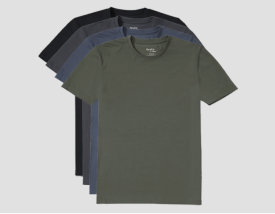Although we’re still in the throes of the COVID-19 pandemic, the rollout of several vaccines has sparked new hopes that life may soon return to normal. That means businesses, schools, venues and of course, workplaces, may soon open up like before. That may not be the most welcoming news for hyperhidrosis sufferers, but they can use the current lockdown to prepare themselves for the reopening. This post will help them do just that by providing tips on how to deal with excessive sweating for workplaces.
Lifestyle Management
First off, we'll start with the importance of making lifestyle changes. Like any other condition, hyperhidrosis requires ongoing management for a sufferer to get relief. With current lockdown measures under effect (at the time of this writing) you likely have some extra time to make some necessary lifestyle changes.
First and foremost, engage in some mindful activities and reflect on what worsens your sweating. What that said take a look at the following and try to identify if certain changes need to be made.
|
Sweat Triggers |
Action(s) |
|
Caffeine |
Reduce consumption or eliminate |
|
Alcohol |
Reduce consumption or eliminate |
|
Greasy Foods |
Reduce consumption or eliminate |
|
Cigarettes |
Eliminate altogether |
|
Prescription Medications |
Speak to your doctor to change dosage or medication altogether (if excessive sweating is a side effect) |
|
Stress/Anxiety |
Practice stress management techniques (more on this below) |
Of course, for many of you, hyperhidrosis doesn't have a known trigger. So simply eliminating the factors above might not be enough. In the case of primary hyperhidrosis, which is the kind that occurs without any known cause, you will likely have to speak with your doctor or a specialist. They can specialize a treatment plan and lifestyle modifications that will help you keep your symptoms under control.
Standard Hyperhidrosis Treatment & Management
As you can see there are quite a few treatment options at your disposal, some of which are standard over-the-counter solutions whereas others are surgical in nature. You may need a combination of them but ultimately your doctor will need to decide which treatment works best for you.
Nevertheless finding the appropriate treatment is your first step in returning back to work if you want to successfully deal with hyperhidrosis. By keeping your symptoms under control, your confidence will stand at an all-time high when it’s time to return to the workplace.
Office Logistics
You may not know for sure what your office arrangements may look like when you return. After all, the pandemic has likely changed things in your workplace and those changes may be permanent. Nevertheless it doesn't hurt to have a game plan when it comes to dealing with your office’s logistics. What do we mean by office logistics?
We’re referring to the setup, routines and facilities at your workplace and how they may affect your hyperhidrosis. For example, meeting rooms or industrial rooms may be uncomfortable for someone with hyperhidrosis because of poor temperature control (ie. the heat being cranked too high). Or maybe you work in a client or customer-facing job that makes it difficult for you to completely mask excessive sweating. These are logistical challenges that make it difficult to hide sweating.
As inescapable as these scenarios or locations may seem, there are workarounds. Take a look at some of the following tactics to see which ones may work for you and your workplace:
- Use alternate greetings and avoid typical one such as handshakes (if possible)
- If handshakes are customary, keep a towel in your pocket to keep your hand as dry as possible before shaking hands
- When giving a presentation, ask if you can sit and use a pointer or clicker rather then lifting your arms
- Keep an extra set of clothes handy if necessary
- If possible, avoid rooms that are excessively warm or adjust the heating in a room if you have permission to do so
- If you are going to attend a work function where certain foods or beverages are served, avoid the ones you think or know may worsen your sweating
- If you have a good working relationship with your supervisors or colleagues, you can open up to them and let them know about your challenges - they may be more accommodating than you think
Working around office logistic challenges is a bit tricky right now because no one really knows how things will change when the workforce gets back into the office. There are also certain workplaces that are very rigid and may not allow for as much flexibility. But that leads to our next point and perhaps the most crucial one you employ.
Equip Yourself With Sweat Resistant Fabrics
If there's one thing you can do for yourself that doesn't require a negotiation or lengthy medical examinations, it’s arming yourself with sweat resistant fabrics. They are non-invasive, they are affordable, you don't need anyone's permission to wear them, and they are totally discreet. Most importantly, sweat resistant fabrics are highly effective at containing sweat, reducing its appearance and keeping you dry.
Managing your hyperhidrosis can start with you wearing a sweat proof undershirt underneath your workplace attire. The overall purpose of a sweat resistant shirt is to make the appearance of sweat less visible to onlookers and also to make you feel more comfortable.
Just think about how that translates to an office setting. Imagine giving a presentation or consulting with a client or explaining a product to a customer. If you are self-conscious of being sweaty and the person you are interacting with is aware that you’re sweating, both of you will become distracted. It affects your confidence and creates a negative impression in the mind of the person you are speaking to.
The opposite is obviously true as well. When you and your customer are not aware of your sweat, you can focus on the task at hand.
How Sweat Resistant Shirts & Fabrics Work to Keep You Comfy & Dry
- Hides sweat - Half the battle of dealing with excessive sweating is ensuring that no one else sees it. The right fabric will hide embarrassing sweat stains so you look dry.
- Provide stain resistance - Sweat stains are a nuisance and they can be hard to remove. Sweatproof shirts should offer a decent measure of stain resistance so that you can easily wash them out.
- Dries fast - The feeling of being drenched at work is distracting and distressing. A sweatproof shirt keeps you relatively dry so that you are not too uncomfortable to focus on your tasks.
- Reduce stickiness - Excessive sweating can also make you feel quite sticky which is irritating and distracting. A high-quality sweat resistant shirt can reduce the sensation of stickiness so that you're not too sidetracked by it.
Our brand of sweat resistant fabrics are adept at all four categories mentioned above. The maze-like patterning of the fabric gives our sweat proof shirts unparalleled moisture-wicking and sweat resistance. You can wear them for both casual and professional settings.
Don’t Sweat a Return to Your Office
For many workers who deal with hyperhidrosis, working from home during the pandemic may have been a blessing in disguise of sorts. Of course, the pandemic itself is not something to celebrate, but not having to shake hands or worry about looking sweaty has been a plus.
With that said, a return to the office is inevitable for many of you, although the timing of this depends on vaccine distribution and the easing of government restrictions. Be sure to prepare yourself for this return by familiarizing yourself with hyperhidrosis solutions.
You might need to do some trial and error and or combine a few of these strategies. But by making the effort beforehand, you can have peace of mind when the time to return to the office comes.








